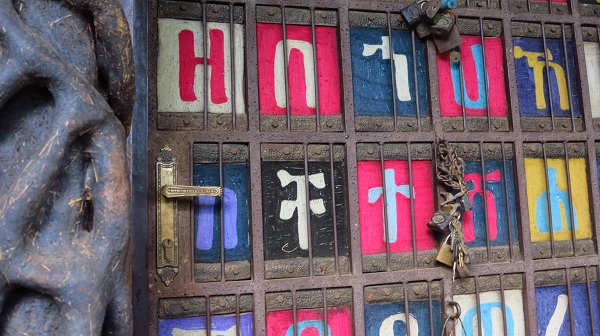
Zoma Museum, previously known as Zoma Contemporary Art Center, is the creation of curator and cultural anthropologist Meskerem Assegued and artist Elias Sime
By Mik Awake (ARTnews)
Behind a corrugated metal gate on an otherwise nondescript swath of land in the Old Airport neighborhood of Addis Ababa is an extraordinary sight: a utopian project taking the form of earthen buildings and gardens nurtured in the name of art. During a visit a few months ago, teams of masons darted here and there, working feverishly in advance of the opening of a new institution for Ethiopia with roots growing back decades. Gardeners in sunhats tended beds of herbs planted in the soil. Bright-colored birds, a rare sight elsewhere in the city, hopped along the steps of an amphitheater hewn from a hill.
This is the site of the Zoma Museum, a new eco-homage to Ethiopia’s indigenous architecture as well as a distinctly African home for contemporary art. A new incarnation of what had previously been known as the Zoma Contemporary Art Center, the Zoma Museum, opening in June, is the creation of curator and cultural anthropologist Meskerem Assegued and artist Elias Sime, who have been working on it in various ways for 20 years, steadily buying up land plot by plot. “If you want to do something good, it takes time,” Assegued told me. “People think we’re rich. But we’re just rich with people—a lot of good people.”
The grounds themselves are a compelling work of Land Art. Looking out across the sloping hills, sightlines deceive and lend perspectival intimacy that toys with a sense of distance. At a glance, it seems that no part of the compound is hidden from view, curving bowl-like and descending to the Akaki River. A central cluster of mud structures, which Elias and his skilled masons have been building over time, will accommodate exhibition space for artists from Africa and around the world, as well as a library, bakery, and café. The museum will also operate a school for vernacular architecture while maintaining a kindergarten that had been started on the property before Zoma became involved.
The inspiration for all this was a road trip around Ethiopia. As we toured the new Zoma grounds, Meskerem described a pivotal journey in the mid-1990s when she was in her twenties. Home on break from studying clinical psychology at a small university in Missouri, she drove north through the Ethiopian towns of Gondar, Wollo, and Yeha. At one point, a stone house caught her eye and captivated her for how it held together, without the use of mortar or cement, by way of an intricate stone-cutting technique. Along the way, she stopped at numerous structures, asking local builders about their methods and documenting her research with photographs. “There were all these techniques all over the country, just hidden,” Meskerem said. “There was an incredible amount of knowledge. This country is rich with that.”
Read the complete story at ARTnews
